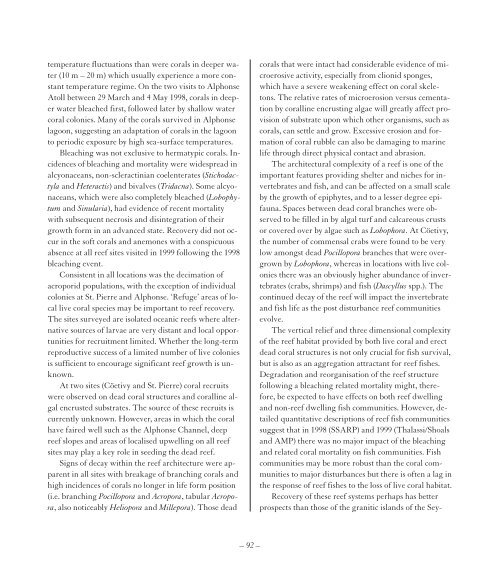You also want an ePaper? Increase the reach of your titles
YUMPU automatically turns print PDFs into web optimized ePapers that Google loves.
temperature fluctuations than were corals in deeper water<br />
(10 m – 20 m) which usually experience a more constant<br />
temperature regime. On the two visits to Alphonse<br />
Atoll between 29 March and 4 May 1998, corals in deeper<br />
water bleached first, followed later by shallow water<br />
coral colonies. Many of the corals survived in Alphonse<br />
lagoon, suggesting an adaptation of corals in the lagoon<br />
to periodic exposure by high sea-surface temperatures.<br />
Bleaching was not exclusive to hermatypic corals. Incidences<br />
of bleaching and mortality were widespread in<br />
alcyonaceans, non-scleractinian coelenterates (Stichodactyla<br />
and Heteractis) and bivalves (Tridacna). Some alcyonaceans,<br />
which were also completely bleached (Lobophytum<br />
and Sinularia), had evidence of recent mortality<br />
with subsequent necrosis and disintegration of their<br />
growth form in an advanced state. Recovery did not occur<br />
in the soft corals and anemones with a conspicuous<br />
absence at all reef sites visited in 1999 following the 1998<br />
bleaching event.<br />
Consistent in all locations was the decimation of<br />
acroporid populations, with the exception of individual<br />
colonies at St. Pierre and Alphonse. ‘Refuge’ areas of local<br />
live coral species may be important to reef recovery.<br />
The sites surveyed are isolated oceanic reefs where alternative<br />
sources of larvae are very distant and local opportunities<br />
for recruitment limited. Whether the long-term<br />
reproductive success of a limited number of live colonies<br />
is sufficient to encourage significant reef growth is unknown.<br />
At two sites (Cöetivy and St. Pierre) coral recruits<br />
were observed on dead coral structures and coralline algal<br />
encrusted substrates. The source of these recruits is<br />
currently unknown. However, areas in which the coral<br />
have faired well such as the Alphonse Channel, deep<br />
reef slopes and areas of localised upwelling on all reef<br />
sites may play a key role in seeding the dead reef.<br />
Signs of decay within the reef architecture were apparent<br />
in all sites with breakage of branching corals and<br />
high incidences of corals no longer in life form position<br />
(i.e. branching Pocillopora and Acropora, tabular Acropora,<br />
also noticeably Heliopora and Millepora). Those dead<br />
corals that were intact had considerable evidence of microerosive<br />
activity, especially from clionid sponges,<br />
which have a severe weakening effect on coral skeletons.<br />
The relative rates of microerosion versus cementation<br />
by coralline encrusting algae will greatly affect provision<br />
of substrate upon which other organisms, such as<br />
corals, can settle and grow. Excessive erosion and formation<br />
of coral rubble can also be damaging to marine<br />
life through direct physical contact and abrasion.<br />
The architectural complexity of a reef is one of the<br />
important features providing shelter and niches for invertebrates<br />
and fish, and can be affected on a small scale<br />
by the growth of epiphytes, and to a lesser degree epifauna.<br />
Spaces between dead coral branches were observed<br />
to be filled in by algal turf and calcareous crusts<br />
or covered over by algae such as Lobophora. At Cöetivy,<br />
the number of commensal crabs were found to be very<br />
low amongst dead Pocillopora branches that were overgrown<br />
by Lobophora, whereas in locations with live colonies<br />
there was an obviously higher abundance of invertebrates<br />
(crabs, shrimps) and fish (Dascyllus spp.). The<br />
continued decay of the reef will impact the invertebrate<br />
and fish life as the post disturbance reef communities<br />
evolve.<br />
The vertical relief and three dimensional complexity<br />
of the reef habitat provided by both live coral and erect<br />
dead coral structures is not only crucial for fish survival,<br />
but is also as an aggregation attractant for reef fishes.<br />
Degradation and reorganisation of the reef structure<br />
following a bleaching related mortality might, therefore,<br />
be expected to have effects on both reef dwelling<br />
and non-reef dwelling fish communities. However, detailed<br />
quantitative descriptions of reef fish communities<br />
suggest that in 1998 (SSARP) and 1999 (Thalassi/Shoals<br />
and AMP) there was no major impact of the bleaching<br />
and related coral mortality on fish communities. Fish<br />
communities may be more robust than the coral communities<br />
to major disturbances but there is often a lag in<br />
the response of reef fishes to the loss of live coral habitat.<br />
Recovery of these reef systems perhaps has better<br />
prospects than those of the granitic islands of the Sey-<br />
– 92 –


















